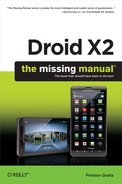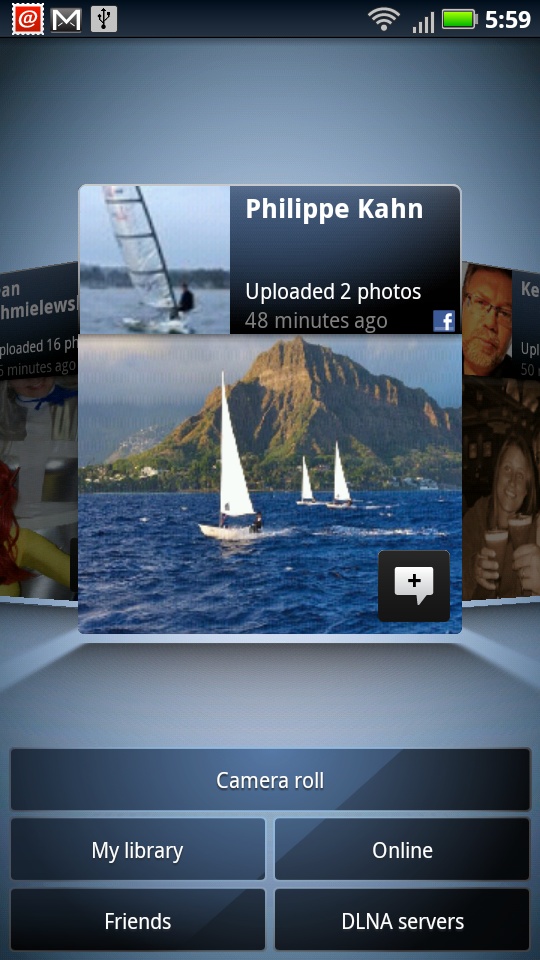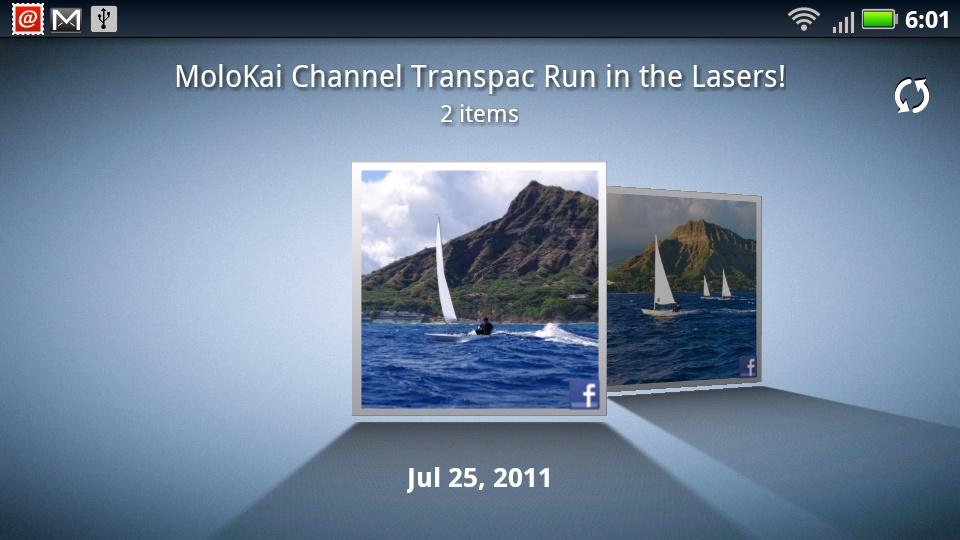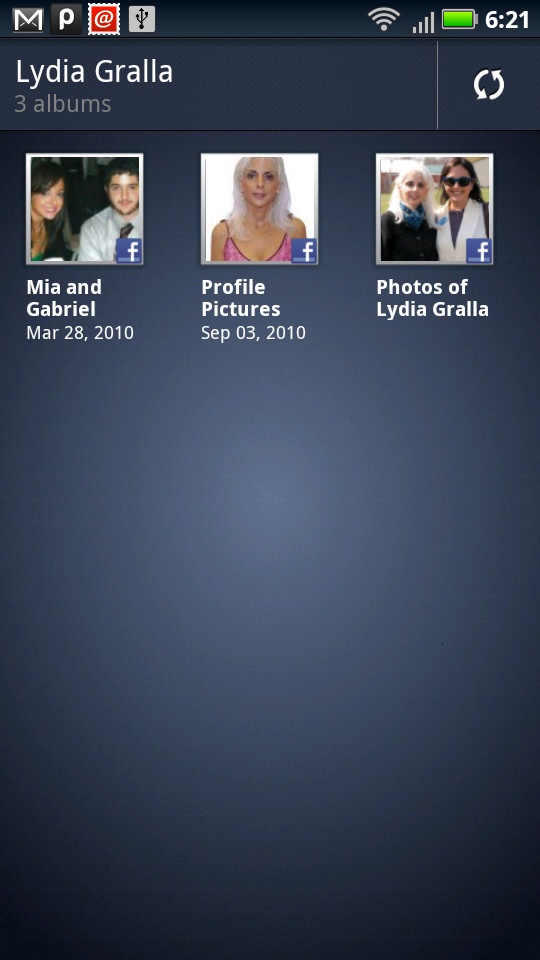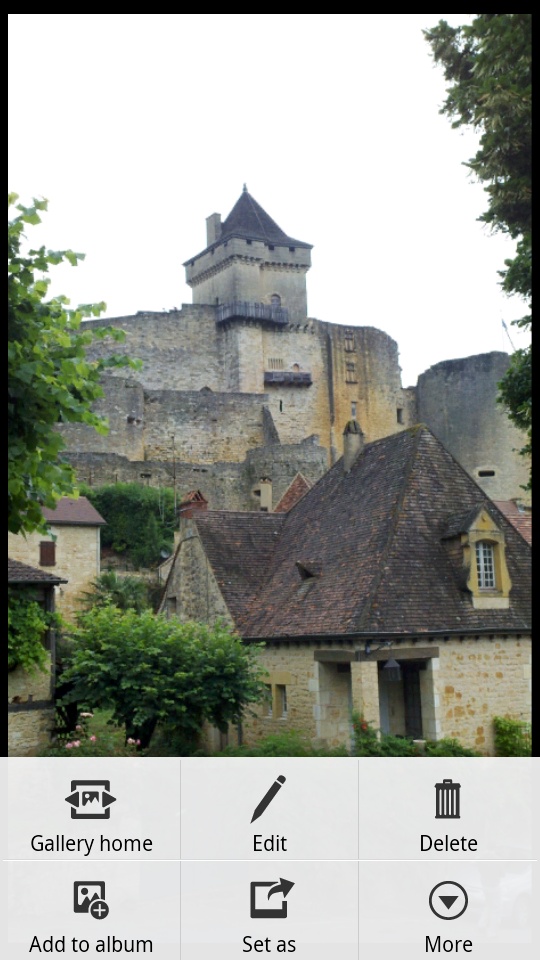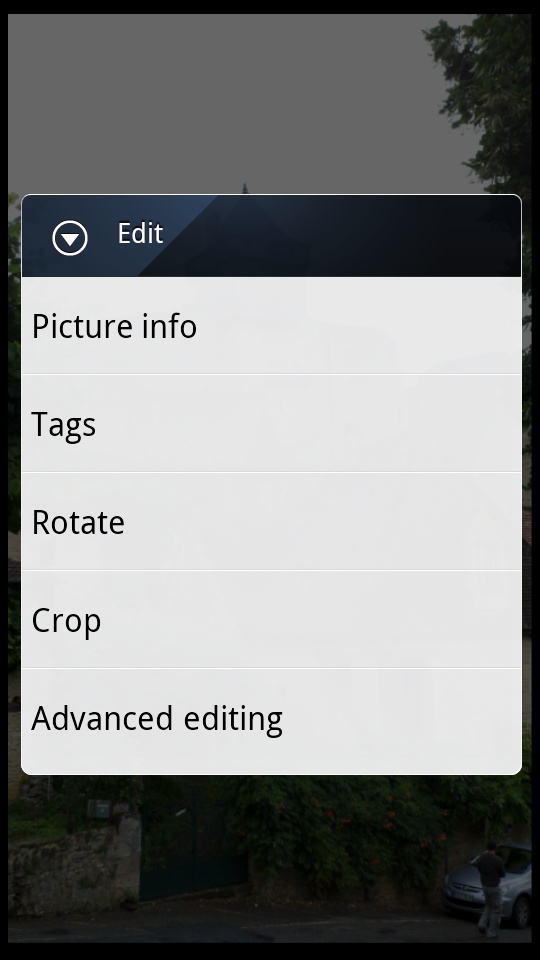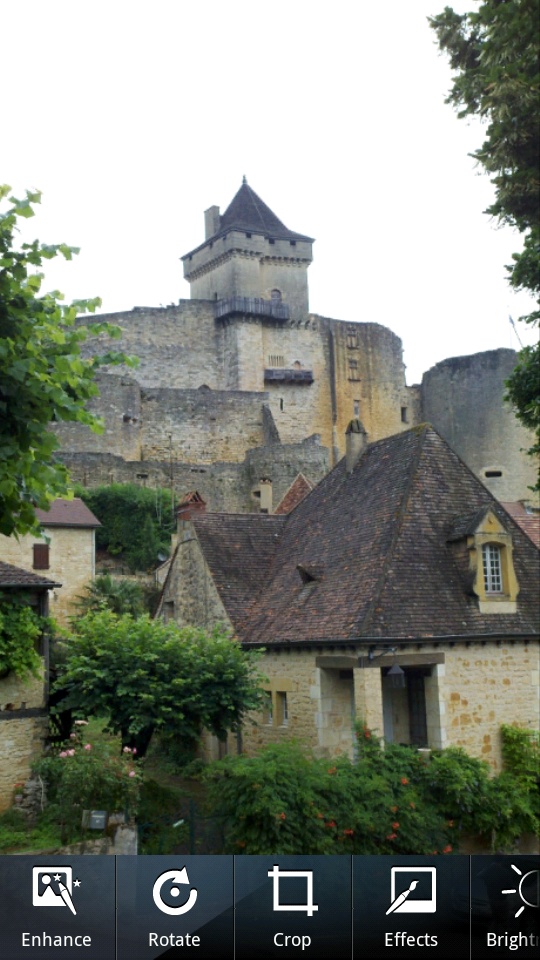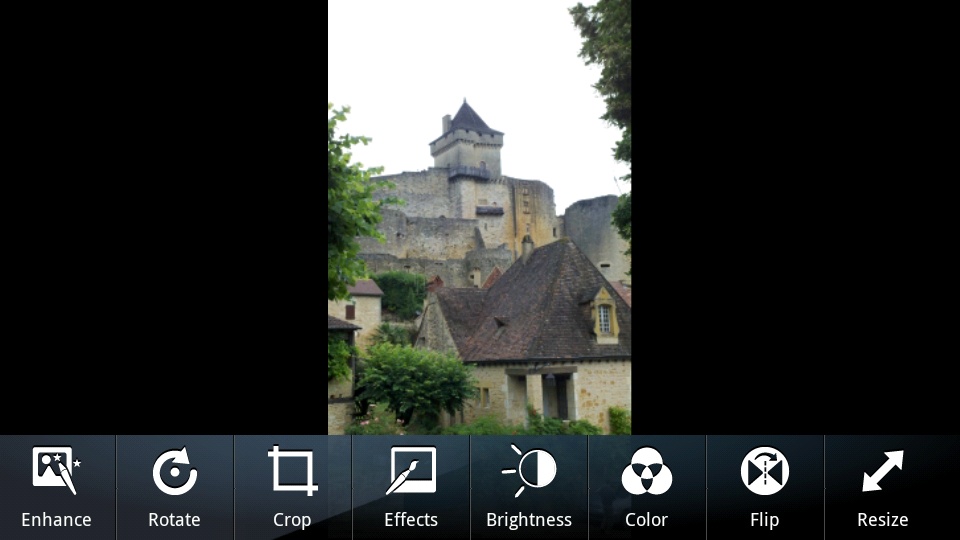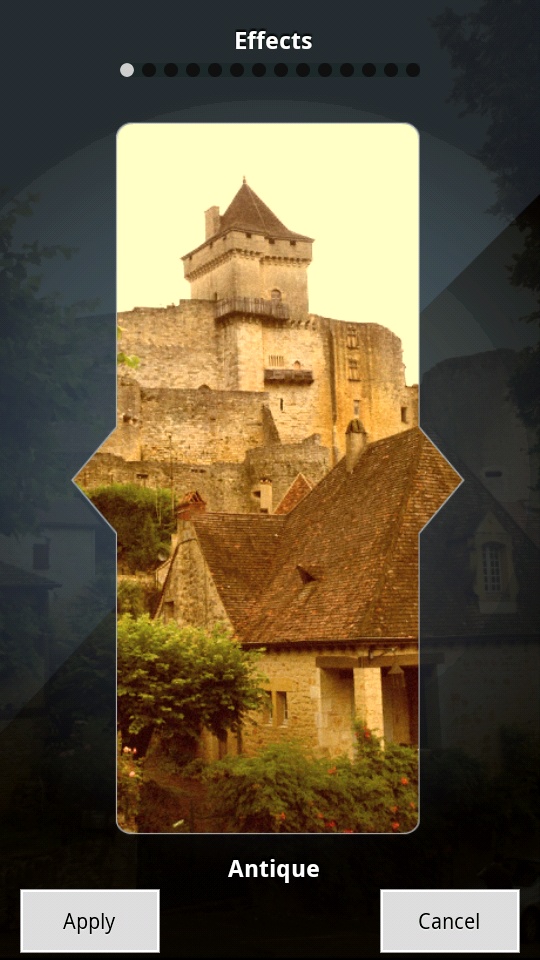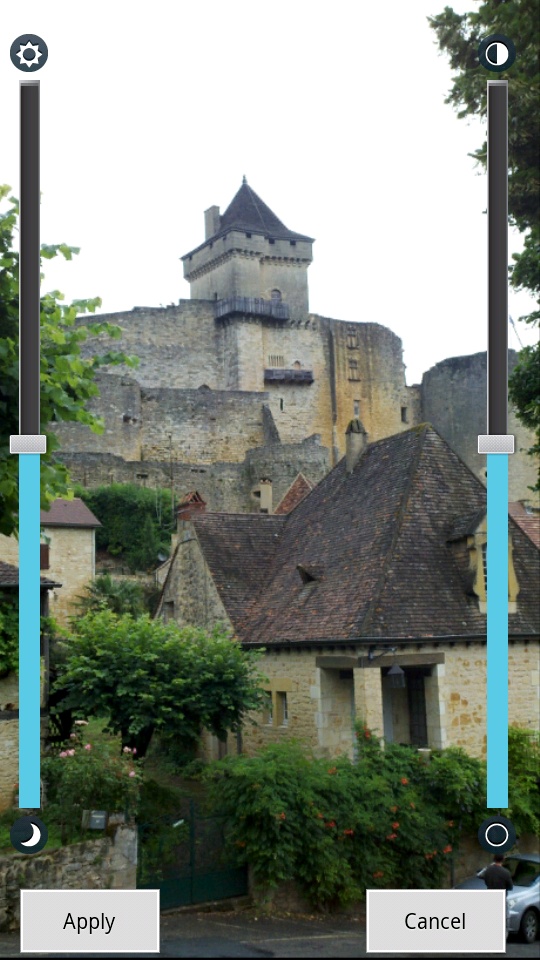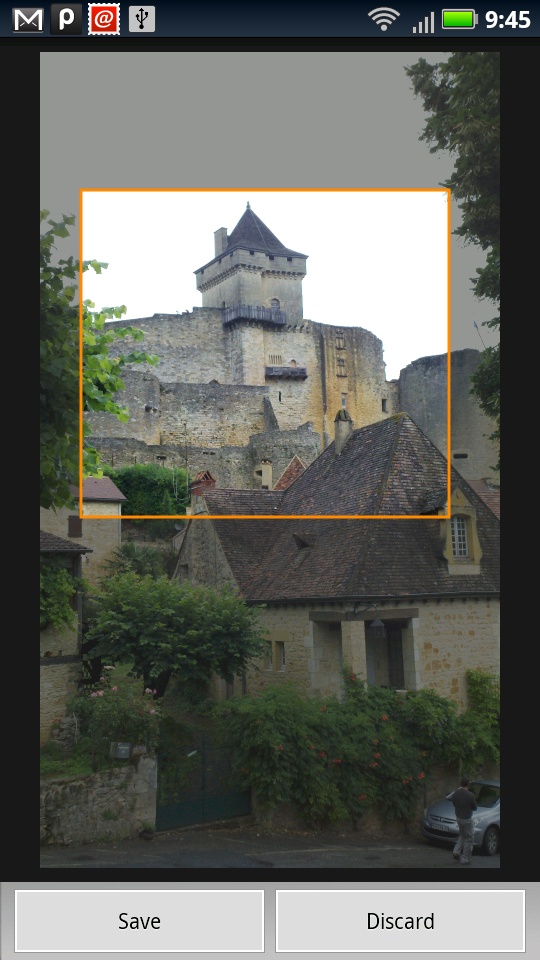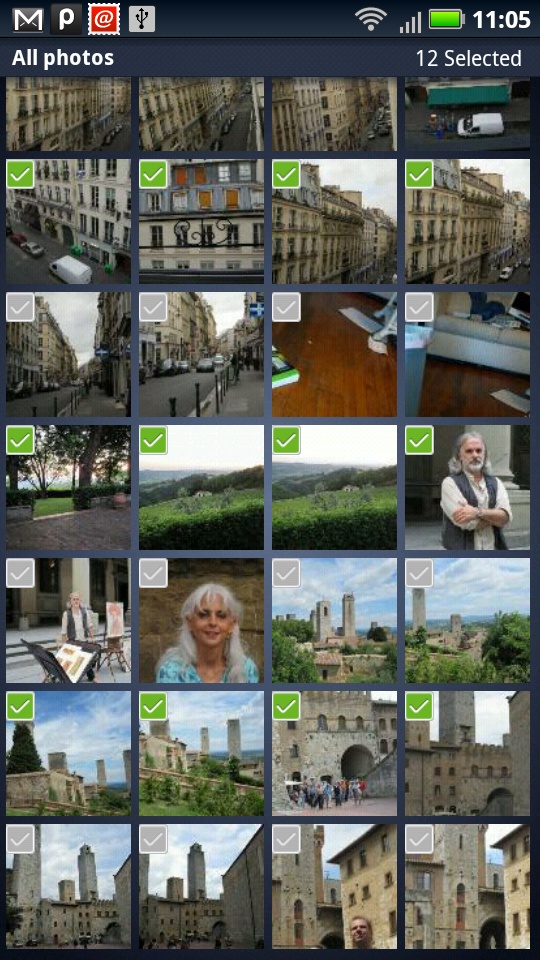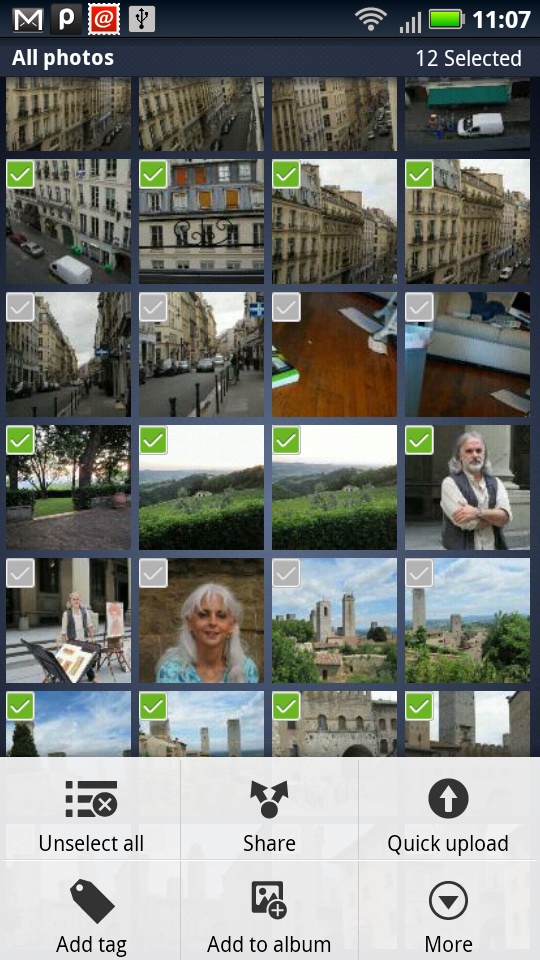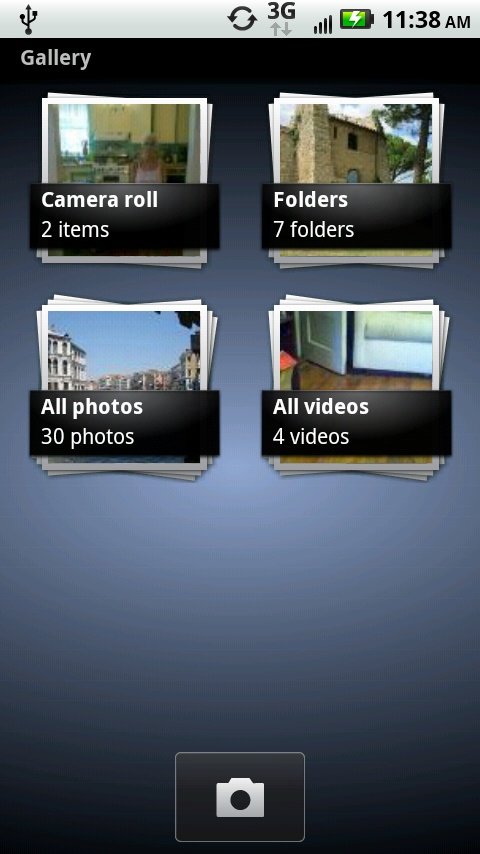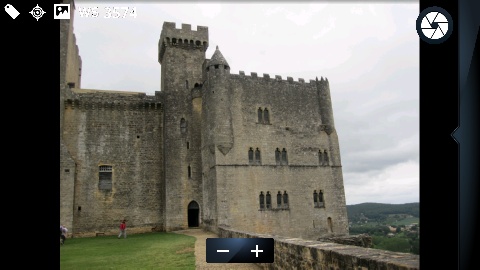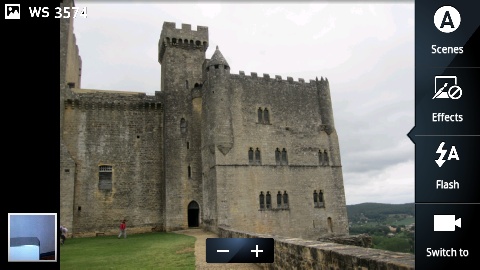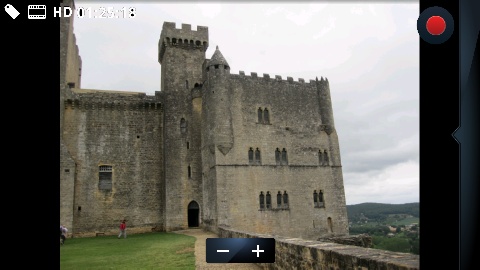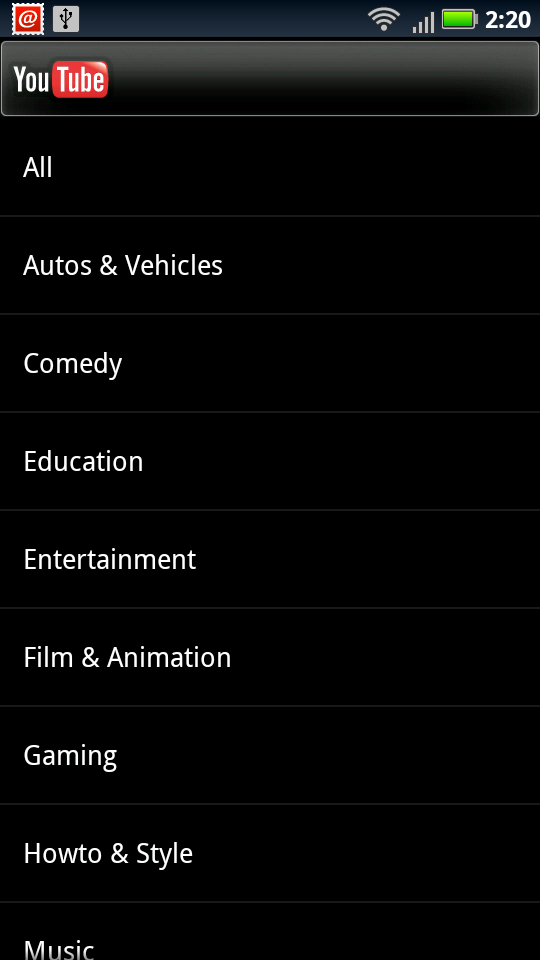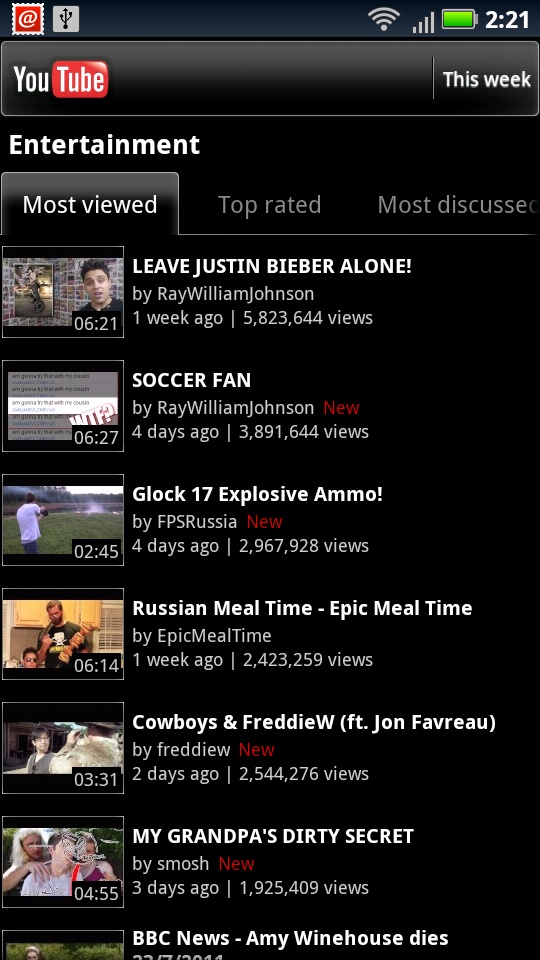Chapter 5. Camera, Photos, and Video
The Droid X2’s 4.3-inch screen is larger than that of other smartphones for a good reason—it’s designed for displaying photos and videos, and for capturing them as well. It has a built-in 5-megapixel camera, so you can take photos in very high resolution. And it also has a built-in camcorder that can take and play back HD (high definition) video.
That’s right, you’ve got more than just a phone in your pocket—you’ve got a multimedia marvel as well. You can even connect it to a TV or other display and watch HD videos or view your high-resolution photos.
This chapter gives you all the details about taking and viewing photos and videos with your Droid X2, viewing pictures and videos transferred to your Droid X2 from your computer, and viewing photos and videos from your Droid X2 on TVs and other monitors.
Opening the Gallery
There are five ways to get photos or videos into your Droid X2:
Transferring them from your PC or Mac (see Chapter 12 for details).
Downloading them from the Web.
Getting them by email.
Friends’ postings on social networking sites like Facebook.
No matter how you get them, though, you view them in the same way, by using the Gallery app. Here’s how to use it:
Note
The Droid X’s gallery differs in several key ways from the Droid X2 gallery, including the screens you see when you open it, and options available to you when you open and view pictures. In addition, there’s no integration with Facebook and other social networking services. See How the Droid X Gallery Differs from the Droid X2’s for details.
In the App Menu, tap the Gallery icon.
The Gallery app launches. Any recent photos your friends have uploaded to social networking sites appear at the center of the screen. Swipe to the left or right through them to see other photos friends have posted. Tap any photo to see it close up, along with the caption, or to see your friend’s full gallery.
Beneath any photos friends have posted from social networking sites you’ll see a variety of ways and places you can view your photos:
Camera roll contains all the photos you’ve taken with the Droid X2.
My Library contains the photos and videos on your Droid X2, organized by album. (It doesn’t have photos that friends have posted to social networking sites, however.)
Online displays any photos that you’ve uploaded to social networking sites, or any photos of you on social networking sites.
Friends lists your friends on social networking sites. Beneath each friend is a listing of how many albums they’ve uploaded. Tap any friend to see the list of his albums. Then tap any album to see all the photos in that album. Tap any photo to see it larger, along with any caption your friend has included.
DLNA lists any servers to which you’re connected. A DLNA server may be a big-screen TV or a PC, for example. You can display your photos on these machines by connecting to them. See Using HDMI to View Photos and Videos on a TV or Monitor for details.
Tap “Camera roll” or “My Library.”
The screen fills with thumbnails of photos themselves, or if you have multiple albums, with a thumbnail of the most recent photo in each album.
Tap an album.
The screen fills with thumbnails of the album. For a moment, the date of the album appears onscreen, but then disappears. Tap the album again to make the date appear again.
Note
Turn your Droid X2 sideways in the gallery, and you’ll see the photos in the Droid X2’s 3D Gallery. Like the music album gallery described on Choosing from the 3D Gallery, it’s a 3D animated interface that lets you flip through pictures, videos, and albums.
Tap the photo you want to view.
The Droid X2 displays the photo on its big, beautiful screen. Now you can see why you wanted the Droid X2—that extra screen real estate compared with other smartphones pays off when viewing photos. For a moment, three icons appear onscreen: The HDMI button at the top
 , the slideshow button
, the slideshow button  , and the information button
, and the information button  . The HDMI button lets you view the photo on a high-definition TV, the slideshow button launches a slideshow on your Droid X2, and the information button provides a variety of details about the photograph, like its size.
. The HDMI button lets you view the photo on a high-definition TV, the slideshow button launches a slideshow on your Droid X2, and the information button provides a variety of details about the photograph, like its size.Depending on the photo’s length-to-width ratio, it may not fill the entire screen. If it doesn’t, you’ll see black space along the sides or at the top and bottom.
For a moment, a variety of icons and information bits appears onscreen:
The share button
 lets you share the photo in many different ways, including on Facebook, by email, and via Bluetooth.
lets you share the photo in many different ways, including on Facebook, by email, and via Bluetooth.The upload button
 lets you upload the photo to your Facebook account or to another social networking or photo-sharing account. (You’ll have to enter your information for that account the first time you upload.)
lets you upload the photo to your Facebook account or to another social networking or photo-sharing account. (You’ll have to enter your information for that account the first time you upload.)The comment button
 lets you add a comment to a photo, but only after you’ve uploaded it to a social networking site such as Facebook.
lets you add a comment to a photo, but only after you’ve uploaded it to a social networking site such as Facebook.Information about the photo appears at the bottom—the file name and date it was taken.
After a moment, the buttons and information disappear, and you see only your photo. To make the three buttons appear again after they vanish, tap the photo.
Viewing Pictures
Now that you’ve got photos on your screen, the fun begins—viewing them in different ways, and flicking through them:
Zooming means magnifying a photo, and you’ve got the power to do that at your fingertips—literally. Double-tap any part of the photo, and you zoom in on that area; double-tap again and you zoom out. You can also use the thumb-and-forefinger spread technique (see The Keyboards) to zoom in more precise increments. Once you’ve zoomed in this way, you can zoom back out by using the two-finger pinch technique.
Panning means to move the photo around the Droid X2’s screen after you’ve zoomed in, so you can see different areas. Use your finger to drag the photo around.
Rotating means to turn your Droid X2 90 degrees so that it’s sideways. When you do so, the photo rotates and fills the screen using the new orientation. This technique is especially useful when you have a horizontal photo that looks small when your Droid X2 is in its normal vertical position. Rotate the phone, and like magic, the picture rotates and fills the screen properly. If you’ve got the phone held horizontally, and you’re viewing a vertical picture, simply rotate the phone 90 degrees, and your photo rotates as well.
Flicking (Touch and Hold) advances you to the next or previous photo in your list. Flick from right to left to view the next photo, and from left to right to view the previous one.
Editing Photos, Slideshows, and More
You can do a lot more with photos on the Droid X2 than just view them or create slideshows with them. You can use a surprisingly powerful built-in photo editing tool, share photos with others, and more. To do any of this, when you’re viewing a photo, press the Menu key, and you’ll find these options:
Gallery Home. Brings you to the screen you see when you launch the Gallery.
Edit. When you use the Droid X2, it’s easy to forget that it’s a computer, and a surprisingly powerful one. And like any computer, it can run powerful photo editing tools. Get to them by tapping this item. When you tap it, you come to a menu that offers basic editing tools—adding tags, or rotating or cropping a photo, adding information to the photo, such as its location, a caption, and a title.
For more tools, tap “Advanced editing,” and across the bottom of the screen you’ll see a menu for a variety of tasks, such as changing the color and brightness, adding effects, and enhancing the photo in a variety of ways. If you’re holding the screen vertically, you can’t see all of your options; flick the icons at the bottom to reveal more. You can instead turn the screen vertically to see all options.
Tap what you want to do, and an easy-to-use screen appears. For example, tap Effects, and you’ll see a preview of your photo with an effect applied, such as Antique, Cartoon, Emboss, or others. Flick through the effects and choose any you would like to apply. When you’re done, tap Apply. To discard your changes, tap Cancel. Similarly to change the brightness, tap Brightness, and the photo loads with two sliders on it, one for controlling brightness and the other for controlling contrast. As you move the slider, you see the editing take effect. When you’re done, tap Apply. To discard your changes, tap Cancel.
Delete. Tap to delete the photo.
Add to Album. If you have a photo that you’d like to add to another of your albums, tap here and then choose the album to which you want to add it.
Set as. Tap this option, and you can set the photo as your profile picture on social networking sites, as a photo for a contact, or as your wallpaper. When you choose it to be your wallpaper, for example, you first get a chance to choose which section you want to be your wallpaper. Choose the section by moving the small box that appears, tap Save, and voilà, you’ve got new wallpaper!
More. Leads to a number of options:
Tap Map, and the Droid X2 looks to see if the photo has location information embedded in it (some cameras, including the Droid X2’s, put this information in automatically; for details, see What’s with All the Icons on the Top of the Screen?). If there’s location information, the Droid X2 displays that on a Google Map. If there’s no location information, you can assign it.
Tap Slideshow, and a slideshow of all the photos in that folder starts to play, beginning with the current photo.
Tap Print, and you can print from your Droid X2 to a retail store that offers remote, wireless photo printing. If your phone knows your location, it automatically displays a list of nearby stores with that service. Otherwise, you can search for a store by typing in your location.
Tap Settings to change your slideshow options, such as how long each photo is displayed before the next one appears, whether to shuffle the photos or play them in order, whether to use transition effects between slides (and if so, which to use), and whether to repeat the slideshow from the beginning when it ends, or simply have it stop. The settings screen also controls other options, such as how to handle quick upload of photos and videos.
Other options include getting information about the picture, and more.
Working with Multiple Photos
In the previous section, you learned about ways to work with individual photos. But what if you want to work with multiple photos at once—give them all the same tag, delete them all, share a specific group of them, or print them all? It’s easy.
When you’re viewing photos in an album, press the Menu key. From the menu that appears, tap the Select Multiple icon  .
.
Note
When you press the Menu key and you’re viewing photos in an Album, the menu that appears includes selections for launching the Camera app, starting a slideshow, going to the front page of the Gallery, grouping photos by the day, week, or month, and accessing Settings.
The current collection of photos you’re viewing appears, with small checkboxes at the bottom of each photo. Tap the photos you want to select—the boxes turn green when selected. If you want to select all photos, press the Menu key and choose “Select all.”
Now that you’ve selected your photos, press the Menu key. You can now share, delete, or print the photos in the same way you share, delete, or print individual photos. You can also add the same tag to them all by pressing the Tag key and then typing the tag you want to add. And you can add the selected photos to another album as well.
Videos in the Gallery
The way you view and work with videos in the Gallery is essentially identical to the way you work with photos, with a few minor differences:
Rotate your Droid X2 by 90 degrees when you’re viewing videos, since they’re usually taken with a horizontal orientation, as are the ones you take on your Droid X2.
When you tap a video, it opens with a right-facing triangle—the Play button. Tap the triangle to play the video. When the video plays, a circle moves along a progress bar to show where you are in the video. Drag the circle forward or back to move forward or back in the video. Tap the Pause button to pause the video; tap the Play button to start playing it again. You’ll also see the total time of the video, and for how long the current video has played.
Note
As with photos, when you first open a video, you’ll see icons on the screen for sharing, uploading, and so on. The icons are identical to those for photos. See Opening the Gallery for details.
To edit a video, select it, press the Menu key, and then tap Edit. A menu appears that lets you add tags to the video, add other information to the video (such as a title, location, and so on), and the ability to edit the video. To edit the video, tap Trim. Across the bottom of the screen you’ll find all your editing options, including adding a title, resizing the video, and removing audio.
How the Droid X Gallery Differs from the Droid X2’s
If you have a Droid X, you’ll see that your Gallery differs somewhat from the Gallery of the Droid X2. Most notably in the Droid X, the main view you see when you tap the Gallery looks different, there is no integration with Facebook and social networking sites, and some features are different.
However, as a general rule, the Gallery’s features and operations are the same. Following are the major key differences between the Droid X and Droid X2 galleries.
Opening the Gallery
Open the Gallery App on the Droid X, and the Gallery screen appears, which is considerably different from that of the Droid X2. At the upper left is your Camera roll, which contains all the photos you’ve taken with the Droid X. It displays a thumbnail of the last photo you took. Also on the screen are other collections of your photos and videos, each also showing a thumbnail of the last photo or video taken. The Folders collection shows all your photos organized by folder—for example, Family, Tahiti (you should be so lucky!), and so on. You’ll also find “All photos,” which contains every photo on your Droid X, and “All videos,” which similarly lists all the videos on your Droid X.
Viewing Albums
As with the Droid X2 gallery, tap any of the collections you see onscreen to see all photos in it. When you’re viewing an entire album and press the Menu key, though, you get a slightly different set of options than you do with the Droid X2. On the Droid X, you get a “Go to” choice that lets you jump to a selection of photos you took in a particular month, rather than being able to group photos by the day, week, or month. And there’s no button on the Droid X menu for jumping to the home of the Gallery.
Viewing Photos
The options available to you when viewing a photo are slightly different, primarily because there is no integration with social networking sites such as Facebook. The buttons that appear when you first load a picture (and that you can make appear again by tapping the picture) are largely the same, with a few differences:
Instead of a comment button, on the bottom right side of the screen, there’s a More button
 . Tap it for options including deleting the photo, setting it as a wallpaper and so on, editing it, printing it, and adding picture info.
. Tap it for options including deleting the photo, setting it as a wallpaper and so on, editing it, printing it, and adding picture info.There is an HDMI button
 on the upper right that will let you view the photo on a high-resolution TV. (For more information about HDMI, see HDMI.)
on the upper right that will let you view the photo on a high-resolution TV. (For more information about HDMI, see HDMI.)
Taking Still Photos
If you’re used to no-frills smartphone cameras that do little more than let you point and shoot in order to take grainy, low-resolution photos, you’re in for a surprise with the Droid X2. It sports a 5-megapixel camera (the Droid X has an 8-megapixel one) that takes vivid photos. Because it’s a camera wrapped inside a computer, it offers plenty of extras, such as multi-shot feature (taking six pictures, one after another), a self-portrait mode, and a panoramic assist that takes multiple photos of a wide area and stitches them together into a panorama.
Note
If you have a Droid X, you can also launch the camera by holding down the Droid X’s Camera key—the large red button on its bottom right. (If you’re holding the Droid X2 horizontally, the button is on the upper right.) You have to unlock the Droid X before you can use the camera key. So if you press the camera when the Droid X is locked, it won’t respond.
Frame your shot on the screen. You can use the camera either in the normal vertical orientation, or turn it 90 degrees for a wider shot. Zoom in and out by tapping the + and – signs at the bottom of the screen. Then tap the onscreen shutter button to take a photograph.
Note
If you have a Droid X, you can also zoom in and out by using its volume keys, which are on the same side as the Camera key. And you can also take a photograph by pressing the Camera key.
You’ll hear the familiar snap sound of a photo being taken.
For a moment or two, a small thumbnail of your new photo stays in the lower left-hand corner of the viewfinder. Tap the thumbnail to get to the Camera Roll—all the photos you’ve taken on the Droid X2. (The Camera Roll doesn’t include any photos you’ve transferred from your computer.)
Note
To learn how to transfer photos between your Droid X2 and your computer, turn to Transferring Files Using Your PC.
What’s with All the Icons on the Top of the Screen?
When you turn on the camera, you see a group of icons and numbers on the upper-left portion of the screen, if you’re holding the Droid X2 horizontally. If you hold it vertically, they range along the upper-right part of the screen. Once you decipher them, they give you useful information about the camera and the photo you’re about to take (or have just taken):
Location information
 . If you let your Droid X2 use location services (Location & Security), this option tells it to find your current location and add it as a tag to your photo. The tag displays here and then quickly fades away. Adding the location tag is commonly known as geotagging.
. If you let your Droid X2 use location services (Location & Security), this option tells it to find your current location and add it as a tag to your photo. The tag displays here and then quickly fades away. Adding the location tag is commonly known as geotagging.GPS indicator
 . When this icon appears, it means that your GPS is on.
. When this icon appears, it means that your GPS is on.Camera indicator
 . When you see this icon, it means that you’re using the still camera. (An icon of a video camera appears when you’re using video instead.)
. When you see this icon, it means that you’re using the still camera. (An icon of a video camera appears when you’re using video instead.)Auto location tag
 . When you see this icon, it means that you’ve told the Droid X2 to automatically put the location tag into your photo. To turn it off (or back on again), press the Menu key, select Tags, and turn off the checkbox next to “Auto location tag.”
. When you see this icon, it means that you’ve told the Droid X2 to automatically put the location tag into your photo. To turn it off (or back on again), press the Menu key, select Tags, and turn off the checkbox next to “Auto location tag.”Resolution
 . Tells you the resolution at which you’re going to take the photo.
. Tells you the resolution at which you’re going to take the photo.Number of photos left
 . Tells how many more photos will fit onto your SD card (if you take them using the current resolution).
. Tells how many more photos will fit onto your SD card (if you take them using the current resolution).
Customizing Your Photo Shooting
Want to make sure you take the best photo possible for your light conditions, and also add special effects, like a sepia tone? Simple—tap the screen, and a menu appears that lets you do sepia and more:
Scenes
 . Helps make sure that you take the best photo possible for your current conditions. Tap the button and flick through your options, including Auto, which is best for a wide range of photos; Portrait, for upper-body shots; Landscape, for big outdoor scenes; Sport, for any situation with a lot of movement; Night portrait, for taking portraits in low-light conditions; Sunset, for twilight conditions; Macro, for close-ups of flowers and other objects; and Steady Shot, to reduce blurring.
. Helps make sure that you take the best photo possible for your current conditions. Tap the button and flick through your options, including Auto, which is best for a wide range of photos; Portrait, for upper-body shots; Landscape, for big outdoor scenes; Sport, for any situation with a lot of movement; Night portrait, for taking portraits in low-light conditions; Sunset, for twilight conditions; Macro, for close-ups of flowers and other objects; and Steady Shot, to reduce blurring.Effects
 . Tap when you’re in the mood for some awesome special effects, including Black and White; Negative for reversing the colors into what looks like a film negative; Sepia for making it look like an old-fashioned brown-toned photo; and Solarize for adding a psychedelic-poster effect.
. Tap when you’re in the mood for some awesome special effects, including Black and White; Negative for reversing the colors into what looks like a film negative; Sepia for making it look like an old-fashioned brown-toned photo; and Solarize for adding a psychedelic-poster effect.Flash
 . Lets you turn the flash on or off, or lets the Droid X2 determine whether to use the flash. In some lighting conditions, you won’t be able to do this, because the Droid X2 will control it automatically.
. Lets you turn the flash on or off, or lets the Droid X2 determine whether to use the flash. In some lighting conditions, you won’t be able to do this, because the Droid X2 will control it automatically.
Using the Best Picture Mode
The Droid X2 gives you more control over your photos, even helping you stitch together big panoramic photos. Press the Menu key and select “Picture modes.” You’ve got the following choices:
Single shot is what you use most of the time, when you don’t need the Droid X2 to do anything special. It’s the mode your camera is in normally.
Panorama lets you take multiple overlapping pictures of a wide panoramic shot. The Droid X2 stitches them together into a single, large panorama. The Droid X2 guides you to take each photo so that it’s overlapping properly.
Tip
You can combine picture modes with Scenes and Effects. For example, you can take a solarized panorama. (You won’t win any photography contests this way, but you can do it.)
Here’s how it works: Tap the button, and take your picture. A small thumbnail of the photo appears on the lower-left portion of the screen, with the indication “1 of 6” above it, and four arrows surrounding it. To take the next photo in the panorama, simply point your camera either up, down, to the right or left, depending on the direction you’re snapping the panorama. The Droid X2 automatically senses when to take the photo, and snaps it for you. Keep doing this until you’ve taken all of the photos in your panorama, and the Droid X2 automatically stitches together the panorama for you. You can do this for up to six photos. If you want to take fewer than six photos for your panorama, tap the square button that’s now in place of the shutter button and the Droid X2 stitches together your photos into a panorama.
Don’t expect panoramas to be perfect. You may notice bending or a jump where the photos are attached.
Multi-shot takes six shots quickly, one right after another. Select this, and when you take a photo, it takes six shots in quick succession. After you take the photos, it displays all six of them; you can then tap any individual photo to delete, edit, and so on, as you would normally for a photo.
If you’ve got a Droid X instead of a Droid X2, there’s an additional mode that shows up when you tap the Menu key:
Self portrait uses a bit of magic to help you take your own picture. Prop up your camera so that it’s pointing at a place where your face will be, select this mode, and then walk over to where the Droid X is pointed and say “Cheese!” As soon as the camera sees your face in the viewfinder, it takes the picture automatically.
Photo Settings
Given the sophistication of the Droid X2, it should come as no surprise that you get plenty of settings to fiddle around with. You certainly don’t need to spend your time doing it, because right out of the box, the settings are good for most photo situations. Most people probably won’t want to while away their time changing these settings, but if you want to change the picture resolution, and choose whether to use features such as face detection, then by all means dig right in.
When you’re in the Camera app, press the Menu key and then tap Settings. Here’s what you can change:
Picture resolution. You get to choose from five settings, ranging from Very Small (2 megapixels) up to Large (8 megapixels) and Widescreen, which uses the widescreen format and takes photos at 6 megapixels.
Video resolution. Controls the camcorder’s resolution. It ranges from a low of 176 x 144, all the way up to High Definition (HD) 720p.
Exposure. Changes the light setting for the viewfinder so you can control how light or dark a photo appears. Choices are between –2 (the darkest) to 2 (the brightest). It’s normally set to 0.
Shutter tone. Like to hear the shutter sound when you take a picture? Then leave this box checked. If you like the sounds of silence, uncheck it.
Storage location. Do you want to store your pictures on your SD card or on the camera’s internal storage? Make your choice here.
Shutter animation. Normally when you take a photo, the screen goes blank for a second, and then the photo appears. If you’d like, though, you can see an animation instead, such as fading down in a circle when the screen goes blank, and then coming up in a circle when it appears again. Tapping this button gives you that option. Choose among None, Circle, and Curtain.
Focus options. Choose here between continuous focus and auto-focus. With continuous focus, the camera is constantly focusing itself, not just when you hold it still. So it’s more likely to be in focus faster in order to take a photo.
If you’ve got a Droid X instead of a Droid X2, there are a few slight differences in the options available to you when you press the Menu key:
Storage location,Shutter animation, and Focus options don’t show up, so you can’t control them.
Face detection is available on the Droid X, but not the Droid X2. When this option is turned on, the Droid X2 camera automatically finds and focuses on faces when you take a photograph. When you’re using this feature, you won’t be able to use the Camera key to focus; face detection does it for you automatically.
Taking Video
To take video, launch the camcorder by tapping its icon on a Home screen or the Apps Menu. If you’re already using the still camera, you can also tap the ![]() icon to switch to Camcorder mode. (Repeat the steps but tap the
icon to switch to Camcorder mode. (Repeat the steps but tap the  icon to switch back to the camera.)
icon to switch back to the camera.)
To start recording, hold down the Camera key all the way or tap the red button, and you’re now recording video. The red button turns into a gray square. To stop recording, press the square. To record without sound, press the Mute button, and to turn sound back on, tap it again.
There are some differences between taking still photos and recording videos. With video:
The scenes you can choose from (tap the screen and then tap Scenes) are different from the ones you can choose for still photos. Your choices are Everyday, for normal video capture and stereo sound; Outdoors, for capturing video outdoors (because it reduces wind sounds); Concert, because it does the best job of reducing distortion in loud music; Narrative, for when you want to comment on the scene you’re capturing; and Subject, when you want to record a person sitting or standing right in front of the camera.
Instead of a flash, the videocam can use a continual light. Tap the screen, then tap Light, and choose whether to have the light on or off when you’re recording.
When you’re in the viewfinder and press the Menu key, an option appears for letting you record video meant to be sent as a message via email or the Internet, or just regular video.
Using HDMI to View Photos and Videos on a TV or Monitor
One of the niftier things about the Droid X2 is that it can display your photos and videos, including HD videos, on a TV or monitor, as long as the TV or monitor has an HDMI slot.
Before you do anything, you’ll need an HDMI cable to connect the Droid X2 to a TV or monitor. You can buy one directly from Motorola online by going to http://bit.ly/c3uBOL. Then follow these steps:
Plug one end of the cable into the HDMI slot on the TV or monitor.
If you have trouble finding it, check the device’s documentation. It’s usually a slot that looks like a trapezoid with a number of pins sticking out of it.
Plug the other end of the cable into the HDMI slot on your Droid X2.
It’s right below the USB slot and is labeled “HDMI” in white, mouse-sized type.
Turn on the TV or monitor, head to the settings where you select HD input, and select HDMI.
Note
The TV or monitor may not recognize the Droid X2 until you actually start playing the video or viewing the photos.
At this point, whatever you see on your Droid X2 shows up on your TV or monitor. So view photos or play videos on your Droid X2, and they’ll play right on your TV or monitor.
YouTube
YouTube is the immensely popular video-sharing and viewing site where people post videos of every type and description, including funny cat tricks, blooper reels, TV snippets, short serial dramas, comedies, ads, musical performances, bizarre films…just about anything you can imagine, and plenty of things that you’ve never imagined.
Note
Droid X alert: When viewed on the Web, YouTube requires the use of a technology called Flash to play videos. Early versions of the Android operating system do not play Flash (some other phones, notably the iPhone, ban Flash altogether). So YouTube uses a different format for videos destined for the YouTube app built into the Droid X. However, depending on your version of Android, you may be able to view videos using the Droid X’s built-in browser. To find out, head to www.youtube.com, open a video, and then tap its start control to play it. You can choose whether to play the video using the Droid X’s built-in YouTube player, or have your browser play it. If your Droid X doesn’t have the most updated version of Android—at least version 2.2—and Flash Player, it can’t play the video. The Droid X2 comes with Flash built in, though, so if you’ve got a Droid X2, you’re all set.
To visit YouTube and search, watch, and share videos, launch the YouTube app in the Application Tray. You come to a page listing a selection of popular YouTube videos—the most viewed videos, the most discussed videos, and featured videos.
Want more information about any of the videos? Tap the little i button  to see the video’s rating, the number of times it’s been viewed, and who created it. From this screen, you can also do the usual YouTube things: Rate the video, comment on it, add it to your Favorites list, share it, or flag it as being inappropriate. You also see a list of related videos. To return to the main YouTube screen, press the Back key.
to see the video’s rating, the number of times it’s been viewed, and who created it. From this screen, you can also do the usual YouTube things: Rate the video, comment on it, add it to your Favorites list, share it, or flag it as being inappropriate. You also see a list of related videos. To return to the main YouTube screen, press the Back key.
Playing a Video
To play a video, tap it. Your screen changes to a horizontal orientation, so turn Droid X2 90 degrees counterclockwise. The video begins playing automatically. If you hold the screen vertically, the video will play in a small box at the top of the screen. You’ll see a variety of YouTube features and navigation onscreen, including information about the video, a list of related videos, comments, the ability to give the video a thumbs-up or a thumbs-down, and so on. Tap the More button at the top of the screen for even more options, such as sharing the video, copying its URL, saving the video, and flagging it for inappropriate content.
Note
When you flag a video as being inappropriate, YouTube will review the video to see whether it violates the company’s guidelines for pornography, drug abuse, gratuitous violence, predatory behavior, and so on.
If you’ve got a Wi-Fi or 3G connection, all’s well. The video will play smoothly and display at a good resolution. If you’re not connected via Wi-Fi or 3G, though, you may be in for a rough ride—grainy resolution, jerky motion, or possibly no play at all.
To control the volume, don’t use YouTube controls. Instead, use the Droid X2’s volume sliders, which are located on the top left of the phone as you’re watching the video.
For plenty of viewing and YouTube options, press the Menu key. You’ll be able to browse and search for videos, upload a video, change YouTube settings, and more.
Finding Videos
With the countless videos available on YouTube, finding one you want to play is easy.
On the main YouTube screen press the Menu key and select Browse. You’ll come to a list of YouTube categories. Tap any category to browse through it.
You can also search YouTube by pressing the Search key when you’re in YouTube, or tapping the Search button at the top of the main YouTube screen.
Recording and Uploading Videos
Want to be a content producer, and shoot your own videos and upload them to YouTube? Your Droid X2 has everything you need to do it.
First, record your video using the Camcorder. Record and save your video. (For more details about how to record videos, see Taking Video.)
Once you’ve saved your video and are back in YouTube, tap the Menu key and select Upload. You must have a YouTube account to upload a video. Select the video you want to upload, follow the onscreen instructions, and the video uploads to YouTube.
